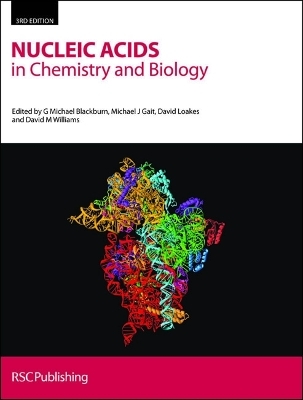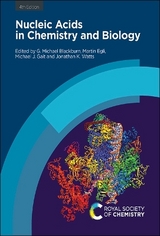
Nucleic Acids in Chemistry and Biology
Royal Society of Chemistry (Verlag)
978-0-85404-654-6 (ISBN)
- Titel gebraucht verfügbar
- Artikel merken
The structure, function and reactions of nucleic acids are central to molecular biology and are crucial for the understanding of complex biological processes involved. Revised and updated Nucleic Acids in Chemistry and Biology 3rd Edition discusses in detail, both the chemistry and biology of nucleic acids and brings RNA into parity with DNA. Written by leading experts, with extensive teaching experience, this new edition provides some updated and expanded coverage of nucleic acid chemistry, reactions and interactions with proteins and drugs. A brief history of the discovery of nucleic acids is followed by a molecularly based introduction to the structure and biological roles of DNA and RNA. Key chapters are devoted to the chemical synthesis of nucleosides and nucleotides, oligonucleotides and their analogues and to analytical techniques applied to nucleic acids. The text is supported by an extensive list of references, making it a definitive reference source. This authoritative book presents topics in an integrated manner and readable style. It is ideal for graduate and undergraduates students of chemistry and biochemistry, as well as new researchers to the field.
Mike Blackburn has been active in chemical biology research for over 50 years, beginning with chemical synthesis of a substrate analogue for ribosomal peptide synthesis (J. Mol. Biol., 1965, 13, 617-628). He studied enzyme mechanisms with W. P. Jencks (Brandeis University, 1966-7) and launched into the use of stable analogues of phosphate esters and anhydrides for studies on nucleotides and glycolysis intermediates from the late ‘70s. This has culminated in the current use of metal fluorides to generate transition state analogues for phosphoryl transfer reactions by kinases, mutases, and isomerases. He has authored some 300 research papers, several patents, one book (“Nucleic Acids in Chemistry and Biology, 3rd Edition, RSC 2005), and is a co-author for more than 70 structures in the Protein Data Bank.
LIST OF CONTRIBUTORS; NOMENCLATURE; 1: INTRODUCTION AND OVERVIEW; 1.1: The Biological Importance of DNA; 1.2: The Origins of Nucleic Acids Research; 1.3: Early Structural Studies on Nucleic Acids; 1.4: The Discovery of the Structure of DNA; 1.5: The Advent of Molecular Biology; 1.6: The Partnership of Chemistry and Biology; 1.7: Frontiers in Nucleic Acids Research; 2: DNA AND RNA STRUCTURE; 2.1: Structures of Components; 2.2: Standard DNA Structures; 2.3: Real DNA Structures; 2.4: Structures of RNA Species; 2.5: Dynamics of Nucleic Acid Structures; 2.6: Higher-order DNA Structures; 3: NUCLEOSIDES AND NUCLEOTIDES; 3.1: Chemical Synthesis of Nucleosides; 3.2: Chemistry of Esters and Anhydrides of Phosphorus Oxyacids; 3.3: Nucleoside Esters of Polyphosphates; 3.4: Biosynthesis of Nucleotides; 3.5: Catabolism of Nucleotides; 3.6: Polymerisation of Nucleotides; 3.7: Therapeutic Applications of Nucleoside Analogues; 4: SYNTHESIS OF OLIGONUCLEOTIDES; 4.1: Synthesis of Oligodeoxyribonucleotides; 4.2: Synthesis of Oligoribonucleotides; 4.3: Enzymatic Synthesis of Oligonucleotides; 4.4: Synthesis of Modified Oligonucleotides; 5: NUCLEIC ACIDS IN BIOTECHNOLOGY; 5.1: DNA Sequence Determination; 5.2: Gene Cloning; 5.3: Enzymes Useful in Gene Manipulation; 5.4: Gene Synthesis; 5.5: The Detection of Nucleic Acids Sequences by Hybridization; 5.6: Gene Mutagenesis; 5.7: Oligonucleotides as Reagents and Therapeutics; 5.8: Footprinting; 6: GENES AND GENOMES; 6.1: Gene Structure; 6.2: Gene Families; 6.3: Intergenic DNA; 6.4: Chromosomes; 6.5: DNA Sequence and Bioinformatics; 6.6: Copying DNA; 6.7: DNA Mutation and Genome Repair; 6.8: DNA Recombination; 7: RNA STRUCTURE AND FUNCTION; 7.1: Overview of RNA Structural Motifs; 7.2: RNA Processing and Modification; 7.3: RNAs in the Protein Factory: Translation; 7.4: RNAs Involved in Export and Transport; 7.5: RNAs and Epigenetic Phenomena; 7.6: RNA Structure and Function in Viral Systems; 8: COVALENT INTERACTIONS OF NUCLEIC ACIDS WITH SMALL MOLECULES AND THEIR REPAIR; 8.1: Hydrolysis of Nucleosides, Nucleotides, and Nucleic Acids;8.2: Reduction of Nucleosides; 8.3: Oxidation of Nucleosides, Nucleotides, and Nucleic Acids; 8.4: Reactions with Nucleophiles; 8.5: Reactions with Electrophiles; 8.6: Reactions with Metabolically Activated Carcinogens; 8.7: Reactions with Anti-cancer Drugs; 8.8: Photochemical Modification of Nucleic Acids; 8.9: Effects of Ionising Radiation on Nucleic Acids; 8.10: Biological Consequences of DNA Alkylation; 8.11: DNA Repair; 9: REVERSIBLE SMALL MOLECULE-NUCLEIC ACID INTERACTIONS; 9.1: Introduction; 9.2: Binding Modes and Sites of Interaction; 9.3: Counter-ion Condensation and Polyelectrolyte Theory; 9.4: Non-specific Outside-edge Interactions; 9.5: Hydration Effects and Water-DNA Interactions; 9.6: DNA Intercalation; 9.7: Interactions in the Minor Groove; 9.8: Intercalation versus Minor Groove Binding; 9.9: Co-operativity in Ligand-DNA Interactions; 9.10: Small Molecule Interactions with Higher-order DNA; 10: PROTEIN-NUCLEIC ACID INTERACTIONS; 10.1: Structural Features of DNA Important in Protein Recognition; 10.2: The Physical Chemistry of Protein-Nucleic Acid Interactions; 10.3: Representative DNA Recognition Motifs; 10.4: Kinetic and Thermodynamic Aspects of Protein-Nucleic Acid Interactions; 10.5: The Specificity of DNA Enzymes; 10.6: DNA Packaging; 10.7: Polymerases; 10.8: Machines that Manipulate Duplex DNA; 10.9: RNA-Protein Interactions and RNA-mediated Assemblies; 11: PHYSICAL AND STRUCTURAL TECHNIQUES APPLIED TO NUCLEIC ACIDS; 11.1: Spectroscopic Techniques; 11.2: Nuclear Magnetic Resonance; 11.3: X-ray Crystallography; 11.4: Hydrodynamic and Separation Methods; 11.5: Microscopy; 11.6: Mass Spectrometry; 11.7: Molecular Modelling and Dynamics
| Erscheint lt. Verlag | 3.11.2006 |
|---|---|
| Co-Autor | Martin Egli, Andy Flavell, Anna Marie Pyle, W David Wilson, S Ihtshamul Haq |
| Zusatzinfo | Not illustrated |
| Verlagsort | Cambridge |
| Sprache | englisch |
| Maße | 189 x 246 mm |
| Gewicht | 1290 g |
| Themenwelt | Naturwissenschaften ► Chemie ► Organische Chemie |
| ISBN-10 | 0-85404-654-2 / 0854046542 |
| ISBN-13 | 978-0-85404-654-6 / 9780854046546 |
| Zustand | Neuware |
| Haben Sie eine Frage zum Produkt? |
aus dem Bereich




